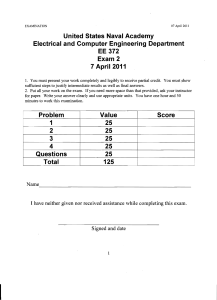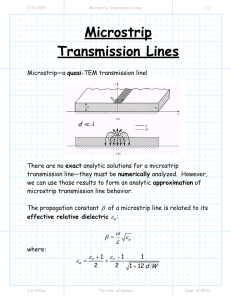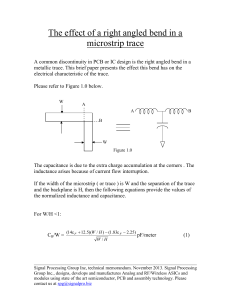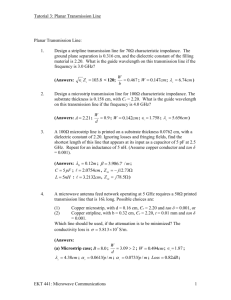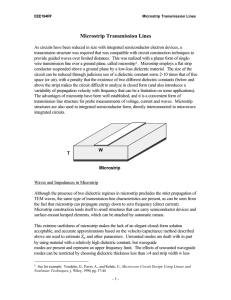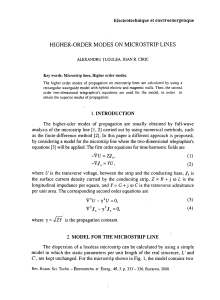A Study on Equivalent Circuit of Short Wavelength Microstrip Line
advertisement
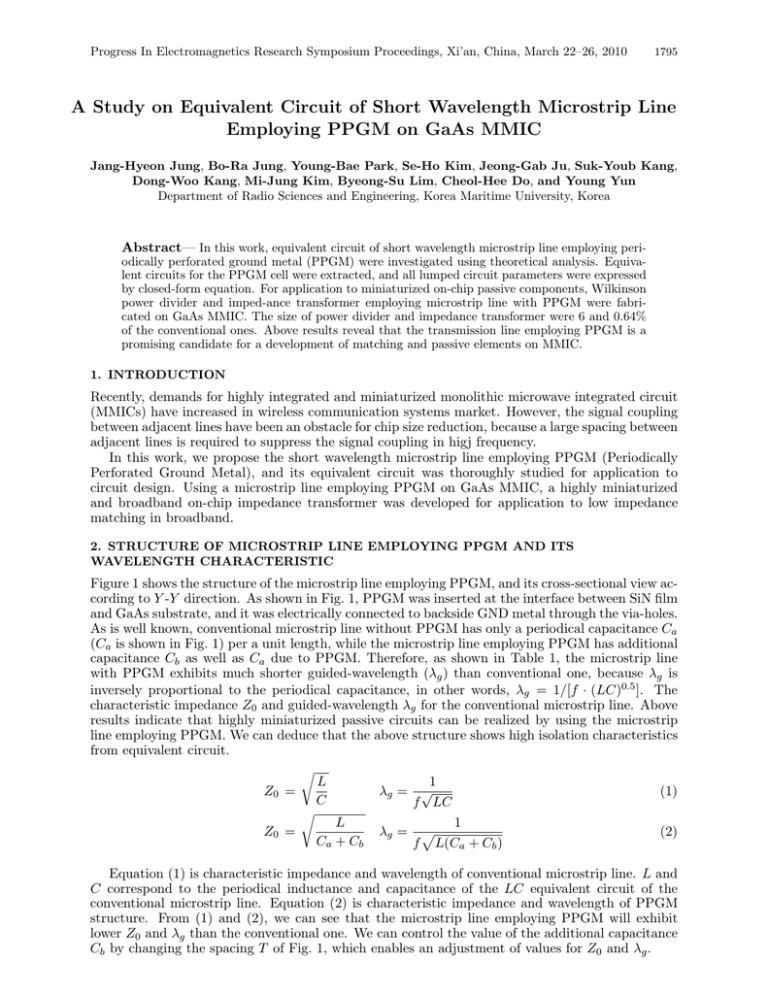
Progress In Electromagnetics Research Symposium Proceedings, Xi’an, China, March 22–26, 2010 1795 A Study on Equivalent Circuit of Short Wavelength Microstrip Line Employing PPGM on GaAs MMIC Jang-Hyeon Jung, Bo-Ra Jung, Young-Bae Park, Se-Ho Kim, Jeong-Gab Ju, Suk-Youb Kang, Dong-Woo Kang, Mi-Jung Kim, Byeong-Su Lim, Cheol-Hee Do, and Young Yun Department of Radio Sciences and Engineering, Korea Maritime University, Korea Abstract— In this work, equivalent circuit of short wavelength microstrip line employing periodically perforated ground metal (PPGM) were investigated using theoretical analysis. Equivalent circuits for the PPGM cell were extracted, and all lumped circuit parameters were expressed by closed-form equation. For application to miniaturized on-chip passive components, Wilkinson power divider and imped-ance transformer employing microstrip line with PPGM were fabricated on GaAs MMIC. The size of power divider and impedance transformer were 6 and 0.64% of the conventional ones. Above results reveal that the transmission line employing PPGM is a promising candidate for a development of matching and passive elements on MMIC. 1. INTRODUCTION Recently, demands for highly integrated and miniaturized monolithic microwave integrated circuit (MMICs) have increased in wireless communication systems market. However, the signal coupling between adjacent lines have been an obstacle for chip size reduction, because a large spacing between adjacent lines is required to suppress the signal coupling in higj frequency. In this work, we propose the short wavelength microstrip line employing PPGM (Periodically Perforated Ground Metal), and its equivalent circuit was thoroughly studied for application to circuit design. Using a microstrip line employing PPGM on GaAs MMIC, a highly miniaturized and broadband on-chip impedance transformer was developed for application to low impedance matching in broadband. 2. STRUCTURE OF MICROSTRIP LINE EMPLOYING PPGM AND ITS WAVELENGTH CHARACTERISTIC Figure 1 shows the structure of the microstrip line employing PPGM, and its cross-sectional view according to Y -Y direction. As shown in Fig. 1, PPGM was inserted at the interface between SiN film and GaAs substrate, and it was electrically connected to backside GND metal through the via-holes. As is well known, conventional microstrip line without PPGM has only a periodical capacitance Ca (Ca is shown in Fig. 1) per a unit length, while the microstrip line employing PPGM has additional capacitance Cb as well as Ca due to PPGM. Therefore, as shown in Table 1, the microstrip line with PPGM exhibits much shorter guided-wavelength (λg ) than conventional one, because λg is inversely proportional to the periodical capacitance, in other words, λg = 1/[f · (LC)0.5 ]. The characteristic impedance Z0 and guided-wavelength λg for the conventional microstrip line. Above results indicate that highly miniaturized passive circuits can be realized by using the microstrip line employing PPGM. We can deduce that the above structure shows high isolation characteristics from equivalent circuit. r 1 L λg = √ Z0 = (1) C f LC r L 1 Z0 = (2) λg = p Ca + Cb f L(Ca + Cb ) Equation (1) is characteristic impedance and wavelength of conventional microstrip line. L and C correspond to the periodical inductance and capacitance of the LC equivalent circuit of the conventional microstrip line. Equation (2) is characteristic impedance and wavelength of PPGM structure. From (1) and (2), we can see that the microstrip line employing PPGM will exhibit lower Z0 and λg than the conventional one. We can control the value of the additional capacitance Cb by changing the spacing T of Fig. 1, which enables an adjustment of values for Z0 and λg . PIERS Proceedings, Xi’an, China, March 22–26, 2010 1796 Figure 1: Structure of microstrip line employing PPGM. Table 1: Measured wavelength (λg ) for the microstrip line employing PPGM and conventional one at 20 GHz. Microstrip line employing PPGM Conventional microstrip line Figure 2: An equivalent circuit for a unit cell of the microstrip line employing PPGM. 2.2 mm 5.6 mm Figure 3: The equivalent circuit for microstrip line employing PPGM. 3. EQUIVALENT CIRCUIT OF MICROSTRIP LINE EMPLOYING PPGM Figure 2 shows the equivalent circuit of adjacent two lines, which corresponds to the equivalent circuit of the N th unit section of the periodic structure surrounded by rectangular box in Fig. 1. Cb corresponds to the capacitance between top line and PPGM, which is shown in Fig. 1, and it is proportional to the cross area W · T of line of line and PPGM (As shown in Fig. 1, W and T are the width of top lines and the periodic strips of PPGM, respectively). Rg and Lg are resistance and inductance originating from the loss and current flow of the periodic strip of PPGM with width T , respectively. Cg corresponds to the capacitance between PPGM and backside metal of GaAs substrate. Lind is parasitic inductance originating from via-holes. Figure 3 shows an equivalent circuit of the microstrip line employing PPGM. As shown in this figure, a number of the equivalent circuits of unit section are connected to each other, and via-hole was expressed as lumped inductor. The capacitance and inductance of the equivalent circuit are given by, " # µ ¶ µ ¶2 T T Lind = 0.0267 − × 0.776 + × 0.0533 nH (3) W W " # µ ¶ µ ¶2 T T Cb = 0.0933 + × 6 × 10−4 − × 1.33 × 10−6 pF (4) di di where, W , T and di are top line width, width of periodic metal strip and the thickness of SiN (See Progress In Electromagnetics Research Symposium Proceedings, Xi’an, China, March 22–26, 2010 1797 Figure 4: Measured and calculated insertion loss S21 for microstrip line employing PPGM. Fig. 1). The whole equivalent circuit is shown in Fig. 3. As shown in this figure, a number of the equivalent circuits of unit section are connected to each other, and via-hole was expressed as lumped inductor. Figure 4 shows measured and calculated insertion loss S21 for microstrip line employing PPGM. For the calculation result, equivalent circuit of Fig. 3 and above closed form equations were used. As shown in this figure, we can observe a fairly good agreement between calculated and measured results. 4. CONCLUSIONS In this work, equivalent circuit of microstrip line employing PPGM were investigated using theoretical analysis. Above result indicates that the transmission lines employing PPGM is very useful for application to compact signal lines of highly integrated MMIC requiring a high isolation characteristics between lines. According to results, a much better isolation characteristic was observed from the adjacent microstrip lines employing PPGM compared with conventional microstrip lines, and the frequency range for high isolation was easily controlled by changing the PPGM structure. For simplification of design process, equivalent circuits for the PPGM cell were extracted, and all lumped circuit parameters were expressed by closed-form equation. The calculated results showed a comparatively good agreement with measured ones. For application to miniaturized on-chip passive components, Wilkinson power divider and impedance transformer employing microstrip line with PPGM were fabricated on GaAs MMIC. The size of power divider and impedance transformer were 6 and 0.64% of the conventional ones. Above results reveal that the transmission line employing PPGM is a promising candidate for a development of matching and passive elements on MMIC. ACKNOWLEDGMENT This research was supported by the MKE(The Ministry of Knowledge Economy), Korea, under the ITRC (Information Technology Research Center) support program supervised by the NIPA (National IT Industry Promotion Agency) (NIPA-2009-C1090-0903-0007). This work was financially supported by the Ministry of Knowledge Economy (MKE) and the Korea Industrial Technology Foundation (KOTEF) through the Human Resource Training Project for Strategic Technology. This work was partly sponsored by KETI (Korea Electronics Technology Institute). This work was also partly supported by ETRI SoC Industry Promotion Center, Human Resource Development Project for IT SoC Architect. REFERENCES 1. Yun, Y., et al., “Basic RF characteristics of the microstrip line employing periodically perforataed ground metal and its application to highly miniaturized on-chip passive components on GaAs MMIC,” IEEE Trans. Microwave Theory Tech., Vol. 54, No. 10, 3805–3817, Oct. 2006. 2. Pozar, D. M., Microwave Engineering, Addison Wesley, Reading, MA, 1990. 3. Yang, F. R., K. P. Ma, Y. Qian, and T. Itoh, “A UC-PBG structure and its applications for microwave circuits,” IEEE Trans. Microwave Theory Tech., Vol. 47, No. 8, 1509–1514, Aug. 1999. 4. Wadell, B. C., Transmission Line Design Handbook, Ch. 3, Artech House, Boston, MA, 1991. 5. Yun, Y., J. W. Jung, K. M. Kim, H. C. Kim, W. J. Jang, H. G. Ji, and H. K. Ahn, “Experimental study on isolation characteristics between adjacent microstrip lines employing periodically perforated ground metal for application to highly integrated GaAs MMICs,” Microwave and Wireless Components Letters, Vol. 17, No. 10, 703–705, Oct. 2007.
